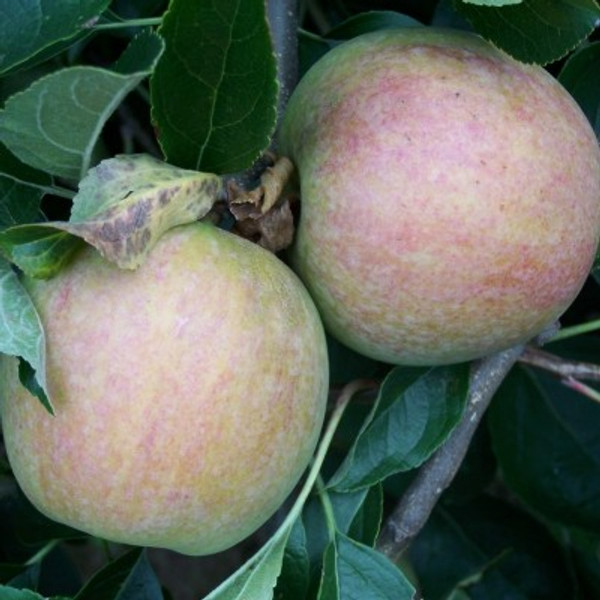Description
Originally named South Lincoln Pippin this cross between King of Pippins and Cox's Orange Pippin was bred by Thomas Laxton of Stamford before 1884. Renamed by Bunyard's of Maidstone in 1896. Medium sized round fruit of distinctly conical shape. Pale yellow with red cheek when fully ripe. Makes a compact tree for a small garden. It is reasonably hardy, and crops well - but can be small or biennial if not thinned. Stores well, with a hint of fruit drops or pineapple flavouring.
"Early in the month we find Allington Pippin coming in season, and very delicious it is at its best. The flesh is of tender and fine grain, at first a little crisp and then becoming as marrowy as James Grieve, which it resembles in flavour plus a pineapple acid and a dozen fragrant suggestions of other fruits. Particular as to soil, demanding sun and open exposure, it must not be judged by the products of a cold and dull summer; the unhappy results of such seasons should pass for the kitchen, as its quince-like flavour is enhanced by cooking, and it makes a pie full of subtle memories."
E. A. Bunyard, The Anatomy of Dessert, 1929
"No wonder that Edward Bunyard speaks so highly of this fruit, introduced by Messrs G. Bunyard & Co.Ltd,. in 1896. It was raised by Thomas Laxton in Lincolnshire as South Lincolnshire Pippin some time before 1884; had a brief moment of glory as Brown's South Lincoln Beauty, receiving an RHS First Class Certificate in 1894; finally being renamed by George Bunyard after his Kent Nursery, 'in 1895 to avoid confusion', says Taylor (The Apples of England, 1936). The 1910 Backhouse Nursery catalogue has it as being of 'Full rich flavour; hardy and robust constitution', but not as a select apple, or for market culture, and it has been found fairly often in old orchards in north Lancashire and in Lanarkshire in Scotland. Widely grown in the early decades of the 20th century as a commercial dessert apple, especially in Kent, Cambridgeshire and the Midlands, it fell from favour on account of being 'too acid for the modern palate', and having suffered storage problems; 'the skin', says Bultitude, is 'subject to Allington Spot a brown breakdown of the lenticels.' Its flowers are susceptible to late spring frost. There are obviously easier apples to grow well then, but some of us have a taste for a brisker apple, and the patience to wait for the mellowing that brings that extraordinary pineapple-peardrop aroma that is seldom found on the super-market shelf. Allington Pippin cooks well, remaining firm; is good for purées, applesauce, and apple butter; it yields interesting juice, which is sometimes used in cider and cider vinegar, and is a moderately good source of vitamin C. It repays good cultivation, careful siting, and the judicious thinning of heavy crops. If what Eden Phillpotts claims is true — 'the scent of quince and Pear, the scent of honey from the hive' — a good year is worth waiting for." © Lin Hawthorne - 'The Northern Pomona'
For help with choosing the correct rootstock for your needs, please click here A Guide to Rootstocks
For help with choosing the correct size and shape, please click here A Guide to Fruit Tree Shapes







